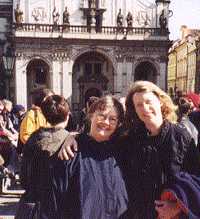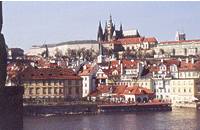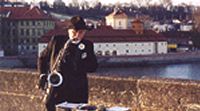Prague Gnosis
By KIRSTIN MILLER
July 2003
 My mother (Peggy Miller) and I on the Charles
Bridge, a pedestrian thoroughfare.
|
I recently returned from Prague, the capital of the Czech Republic and one of the most beautiful cities on earth. With one sweep of the eye, you can easily take in at least five centuries of fantastic architectural design and detail. Wander down any alleyway and you'll run into an historically famous person's former hangout. Some of the most celebrated minds in European history—Beethoven, Mozart, Dvorak, Franz Kafka, Johannes Kepler, Tycho Brahe and Ranier Marie Rilke, to name but a few—have imbued this city with their timeless magic. Music and musicians are everywhere in Prague. Over the course of two days, I counted ten people carrying cellos!
I went to Prague to represent Ecocity Builders—a Berkeley, California, based environmental NGO—at Towards Car Free Cities III, an international conference hosted by the feisty Car Busters Magazine. I was there to present innovative methods for transforming cities and towns to exist in balance, instead of in competition, with nature.
My traveling companion was my own mother, which made the adventure even more interesting because we'd never traveled together before, just the two of us. Mom came as a conference participant, representing MIST (Missoula (Montana) Institute of Sustainable Transportation). She was an instant hit with everyone at the conference—mostly young activists from Eastern Europe—and this came as no surprise to me. Almost everybody she meets pours out their innermost sectets to her within ten minutes. While I tend to talk about ideas and projects, Mom finds out about the person, inside and out. We made good traveling companions, because we each had a unique perspective on the day's events. I would tell her about so-and-so's strategy for successful implementation of car-free development projects, and she would tell me about how so-and-so was engaged to be married, or worried about his or her career, or nervous about speaking English.
Our conference headquarters was the ancient Toulcuv Dvur Estate, located some distance from the city's old center. Since 1994, the facility has been used for environmental education and to host conferences such as ours. Simply designed new buildings compliment a Gothic granary and Baroque stables. Estate records, we were told, date back to 1362, when the compound belonged to the Sazava Monastery.
 |
|
| Prague (click for a larger image) |
|
|
When heavy topics such as |
|
Our days were spent in earnest discussions and focused planning sessions. Contemplating the transformation away from the automobile is an enormous mental challenge. Sometimes talks grew heated, but we always ended the day in friendship. Workshops focused on car-free development projects, bicycle tourism and greenways, how to promote car-free lifestyles and how to expand the car-free cities movement worldwide.
In Prague and everywhere else, these topics seem to attract the extra determined; those who believe they have a responsibility to try to stop the disaster from spreading, even in its present advanced stages. When heavy topics such as "rebuilding civilization" are what's at stake, maintaining balance is always beneficial. Socializing and relaxation are essential, and our Car Busters hosts at Towards Car Free Cities III knew this. In the late afternoons, large brown bottles of Pilsner beer were passed out to the mentally over-stimulated. We watched short films made by conference goers and even had a cultural exchange event where we sampled each other's special foods and drinks. (I highly recommend Becherovka, a delicious spirit produced since 1807 in Karlovy Vary village from a secret mixture of herbs and spices. Drink it neat and very cold.
|
A car-free world isn't |
A car-free world isn't really something you can work towards in little ways. Big, huge, amazing transformations have to happen. This knowledge creates a certain amount of tension and frustration when activists get together and try to brainstorm ways to change the world. "Bike to work" days are educational, but they don't address the structure of the city itself. Millions of acres of soil currently lie suffocated beneath a cancerous blanket of sprawl that is spreading ever outward over the surface of the earth. Cars, the agent spreading this disease, cleverly mutate into other forms in an attempt to throw consumers off guard. The promise of "hybrids" and electric vehicles dull the public's memory of once fertile farmlands, creeks and wetlands, and precious habitat now silenced beneath asphalt and concrete.
To make matters worse, many scientists and environmentalists—those who should be examining the built infrastructure from a whole systems ecological perspective—have become hypnotized and fascinated with technology and fine tuning the disaster. Or, if they aren't busy thinking about how to make cars easier to defend socially and politically, they are brushing aside the problem, as if even talking about it will contaminate their chances for foundation funding. For example, in San Francisco, Ecocity Builders' President Richard Register and I attended a City Arts & Lectures program for the California Academy of Sciences featuring primatologist Russell Mittermeier and science writer David Quammen. They are both brilliant men. However, after spending a few hours telling us all about the decline of species and the need to find ways to conserve what's left, both went silent when asked how the built environment impacts the biosphere and what we could do to reverse the damage. "We don't even want to get into that," they told us. "That discussion would take another two hours," Mittermeier said.
|
 |
|
| The famous Charles Bridge linking Stare Mesto
with Prague's "Old Town." (click for a larger image) |
|
|
The solution is obvious:
|
Well, it's going to take much more than that, as those of us who attended the Car Free conference know. Just when we are realizing the catastrophic potential of CO2 build-up in the atmosphere, sprawl development, probably its largest single cause, is paving the way for two billion new drivers in the next ten to twenty years. The solution is obvious: stop building for the automobile, roll back sprawl and rebuild civilization in balance with living systems. This is our challenge, but only a handful is even willing to talk about it. It's a great disappointment to me and other activists trying to facilitate whole systems change. What can I do if highly respected scientists and environmentalists are refusing to face the challenge themselves? (I suppose I could join one of those progressive Zen encounter groups and participate in rituals that act out the pain I feel for lost species, for the dying plants and animals. But what good is that going to do for the biosphere?)
Most who attended Towards Car Free Cities III didn't have Ph.D.s, but most of us did have common sense, and that's really all you need to figure out what needs fixing. It's the built infrastructure that has the biggest impact on the biosphere. Yet even in cities like Prague, and in other pedestrian and transit centered places like Curitiba, Brazil, that offer large areas focused primarily on the measure of the human body, sprawl is at work. Outside the protected haven of the car-free pedestrian zones, the automobile quickly asserts dominance, forcing people out of the streets and replacing civilized social interaction with danger, noise and poisonous exhaust. But we can still learn a great deal from what does work in these cities; primarily the places without cars that are meant for people.
Wandering the pedestrian streets of Prague with my mom and a dozen young people from all over Europe was a crash course in just a few of the benefits of car-free urban environments. We strolled along the romantic Vltava River, across spacious public squares, through narrow twisting alleyways and into small intimate courtyards. The pedestrian streets were meant for our feet. We didn't have to look both ways to avoid getting run over. Without the sound, smell and sight of traffic, it was easy to understand how areas meant for people make life more exciting and interactive. With lots of people comfortably out in the open, there is more life in the city. It seems so obvious, but obviously is not a concern to city planners in most cities, where cars take up most of the room and people are squeezed onto narrow sidewalks.
|
Wandering the pedestrian |
Yes, it's all in the design! And we can't go back to the past, much as many of us would like to. With six billion people on the planet, we can't build four to six story cities and expect to make room for nature. But if we learn to think in the third dimension and use terracing and step back as we build up; if we plant rooftop gardens and invite in native birds and provide high places for the people to visit, work or live, why can't we imagine really beautiful taller cities full of life and inspiration? Such buildings, and cities made up largely of such buildings, would be part of an ecologically and socially healthy whole living organism. This was the message I came to deliver on behalf of Ecocity Builders at the public day at Kino Areo, a theater in the Stare Mesto district, much nearer the old town center than Toulcuv Dvur but easy to reach by public transportation.
Yet while Prague has many fabulous historical and cultural amenities, it isn't a city that embraces nature to any large extent. A good example of a city that has adopted many ecological principles and is able to think in the third dimension is Curitiba, Brazil. Starting around 1972, then Mayor, now Governor Jaime Lerner coordinated the development of Curitiba's bus system on "dedicated streets"—that is, streets dedicated for buses only—with higher density housing and centers of community services and activities built along those streets. There are also twenty-seven blocks of pedestrian streets, dozens of beautiful squares and plazas, enormous parkland and semi-natural open spaces graced by rivers and streams.
|
With six billion people |
While attending the Fourth International Ecocity Conference in 2000 in Curitiba, I had the privilege of interviewing Governor Lerner. Here are a few of his words about planning that I'd like to share with you. He says, "Always, always, in every proposal, you have to have behind it a general view about people. You must be an optimist when dealing with people. That's not being naïve. It's the view that changing is possible. As soon as you realize the importance of the change, it has been always, in this city, an educational process. You cannot respect the city, the environment, if you don't understand it. We started making the process understandable." He also said, "Planning is not a process of projecting tendencies; it's a process of change. If you project bad tendencies, if you project the tragedy, you'll have the tragedy."
We cannot put aside our dreams of a better future. We have to believe that change is possible, and that with lots of determination, we can begin to reverse the tragedy and start planning for a future that respects our humanity and the environment. But until we actually demonstrate new ways of creating a human habitat free of enslavement to an oil-based infrastructure, we won't plan for a better world; we'll only be playing out the tragedy and projecting bad tendencies. Cities are the largest things humans create. The city makes connections possible because it brings so many different things together: people, ideas, machines, tools, disciplines, memories, literature, art, everything! In its very physical structure, the city either makes things happen, or prevents them from happening.
The Earth weighs 5.972 sextillion metric tons and travels through space at 67,062 miles per hour. Life exists on top of its thin crust, which we are ever so busily paving over to build our habitat. This miracle is our home. Let's depave the world, and let's start today! Let's build our cities for people, not machines. I hope you will join us, we need you.
Kirstin Miller is the program director for Ecocity Builders (ecocity@igc.org). She lives in Berkeley, California.
. . .
We at ECOTECTURE welcome you feedback. Address
your comments on articles or other matters to editor@ecotecture.com.
If you want them published, put "LETTER TO THE EDITOR" at the top
of the page.
-PSW and the ECOTECTURE Associates